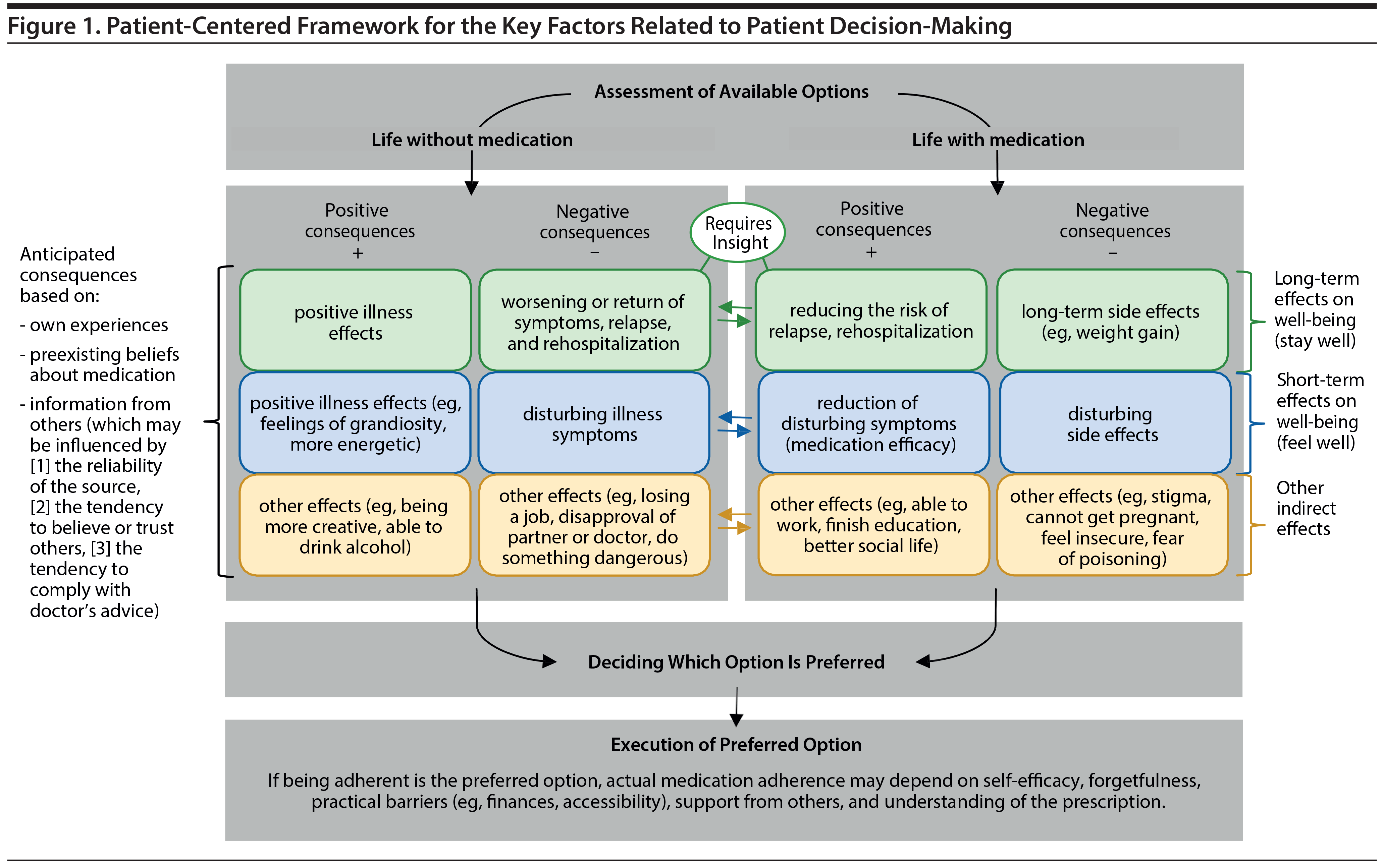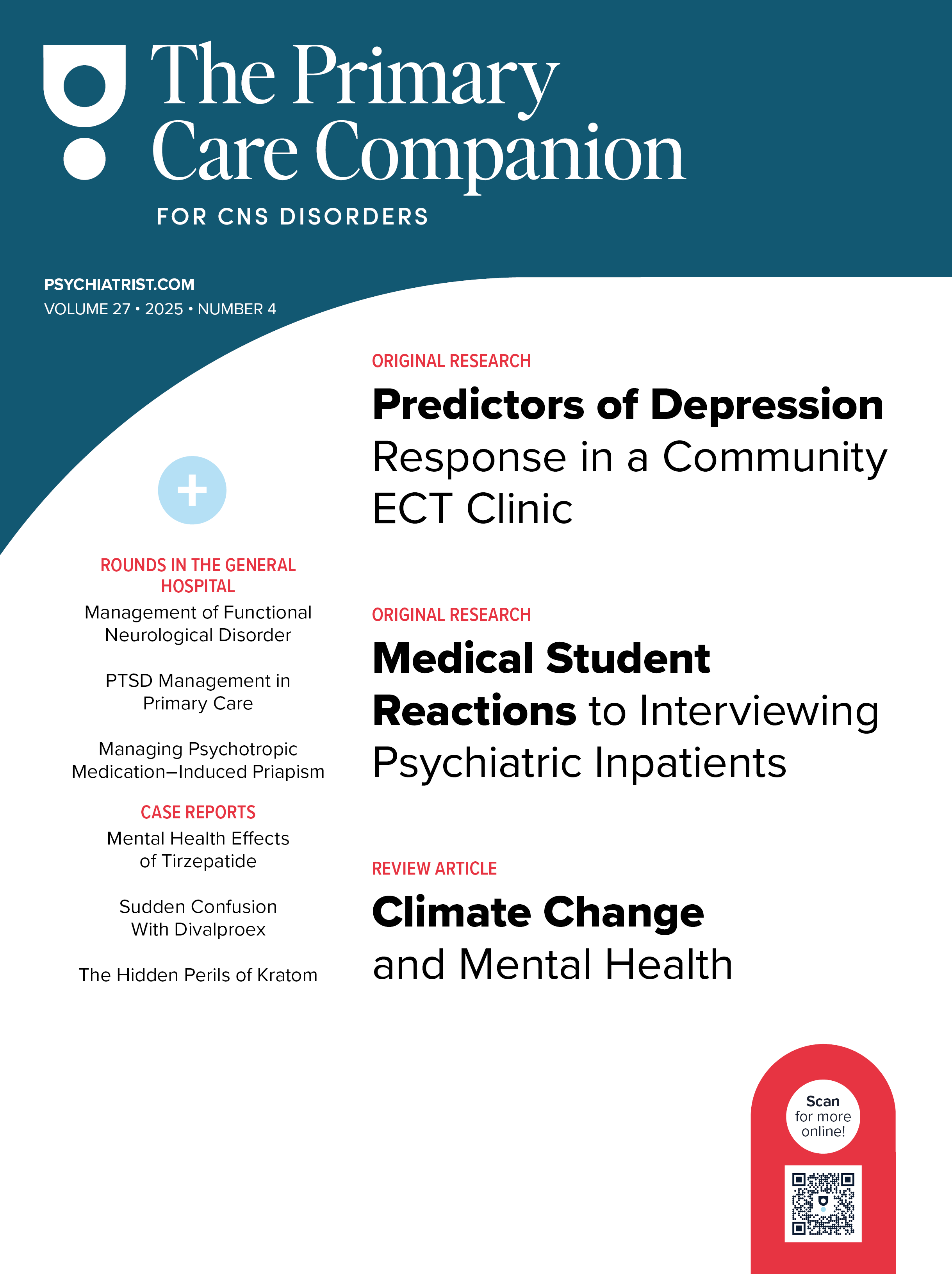Medication nonadherence is common in patients with schizophrenia. Nonadherence affects approximately half of all patients and may increase the risk of relapse and hospitalization. Although it is an intensively studied phenomenon, we have little understanding of underlying mechanisms leading to nonadherence. In this article, using quantitative and qualitative study results and psychological decision theory, we present a model of medication adherence decisions in patients with schizophrenia that may be useful for clinicians and those involved in the development of adherence interventions or adherence research. The model focuses on the function and meaning of medication from a patient perspective. Although the model is a simplified description of the decision-making process related to medication use, it does explain the role of some important aspects such as insight, side effects, efficacy, and social influences. We also discuss how this may explain the high and persistent rates of nonadherence. Finally, we discuss some implications for clinical practice.’ ‹’ ‹
Medication Adherence Decisions in Patients With Schizophrenia
ABSTRACT
Medication nonadherence is common in patients with schizophrenia. Nonadherence affects approximately half of all patients and may increase the risk of relapse and hospitalization. Although it is an intensively studied phenomenon, we have little understanding of underlying mechanisms leading to nonadherence. In this article, using quantitative and qualitative study results and psychological decision theory, we present a model of medication adherence decisions in patients with schizophrenia that may be useful for clinicians and those involved in the development of adherence interventions or adherence research. The model focuses on the function and meaning of medication from a patient perspective. Although the model is a simplified description of the decision-making process related to medication use, it does explain the role of some important aspects such as insight, side effects, efficacy, and social influences. We also discuss how this may explain the high and persistent rates of nonadherence. Finally, we discuss some implications for clinical practice.
Prim Care Companion CNS Disord 2017;19(6):17n02182
https://doi.org/10.4088/PCC.17n02182
© Copyright 2017 Physicians Postgraduate Press, Inc.
aResearch Department, Arkin Mental Health Care Institute, Amsterdam, The Netherlands
*Corresponding author: Martijn J. Kikkert, PhD, Research Department, Arkin Mental Health Care Institute, Klaprozenweg 111, Amsterdam, Noord Holland 1033 NN, The Netherlands ([email protected]).
Schizophrenia is a severe mental disorder for which medication is considered to be the most effective treatment. Half a century ago, Parkes et al1 and Renton et al2 established that 45% of patients with schizophrenia failed to take their medication as instructed. Several studies3–6 have shown that the level of nonadherence is still the same today. Systematic reviews3–6 have found an average nonadherence prevalence of between 40% and 55%. This means that, despite all the research efforts and the development of adherence interventions and new medications, we have been unable to improve adherence behavior in the last half century. Although extensive research has increased our knowledge, much is still unknown, and breakthroughs have not been achieved. We do know that nonadherence results in an increased risk of relapse and hospitalization and that it is associated with high economic costs.7–17 Unfortunately, a clear solution to this problem is not yet found. In this article, we present a model of medication adherence that may be useful in clinical practice.
DETERMINANTS OF NONADHERENCE
A first and indispensable step in finding solutions that really work is understanding why patients stop using their medication. Many studies have been performed to find factors associated with, or predictors of, nonadherence in patients with schizophrenia. Several published reviews4,5,18–24 have included a systematic literature search on risk factors. Most of these authors determined that they could not arrive at any conclusions about many of the variables included in their review because the study results were too inconsistent or conflicting. But even between reviewers, there is disagreement concerning which factors do or do not affect adherence, which may be due to different methodologies, study samples, and individual differences. There are, however, several factors for which most reviewers agree that are higher in nonadherent patients such as substance abuse, rates of positive symptoms, disorganization, and symptom severity. Furthermore, most reviewers conclude that adherence is better if patients have insight, positive attitudes toward medication, and belief or experience that medication is effective. A good therapeutic alliance is also consistently associated with medication adherence. Finally, patients who receive no support from their relatives, who live alone, and who do not have supervised medication intake are generally more nonadherent.
Although we know that these factors are associated with nonadherence, few attempts have been made to explain how they relate to patients’ decision-making processes. In fact, adherence in patients is often described as a “black box phenomena.” As a consequence, our understanding of the mechanisms underlying nonadherence is poor.4,25,26 For instance, for most of the factors described, we do not know how or why they influence adherence. The absence of a model that explains the role of all major determinants of nonadherence is considered one of the main problems in adherence research.
A PATIENT-CENTERED MODEL
OF MEDICATION ADHERENCE
Medication adherence is about the choices made by individual patients. In an attempt to develop a model that gives us insight into these choices, we resort to the different psychological models that have been developed to explain how people make health-related decisions.27 Despite the extensive literature on this topic, there have been few attempts to apply these models to patient decisions about medication use. Exceptions are some older models such as the Theory of Planned Behavior,28 the Self-Regulatory Model,29 and the Health Belief Model, which is probably the best known.30,31 The Health Belief Model has been used by several researchers to explain patient behavior.5,32–34 It is a psychological model initially developed to explain the reluctance of people to make use of a health program. It was developed by Becker and colleagues30,31 in the 70s and 80s and is based on the value expectancy theory. This theory states that patient behavior depends on the subjective importance of an outcome and the subjective expectation that a particular behavior will achieve that outcome. It is a generic model that we will try to adapt to describe medication decision processes. For this we examined, next to quantitative studies, qualitative studies that focus on medication adherence in schizophrenia. These sources provide more first-person perspective and therefore form a valuable supplement to quantitative studies.
On the basis of the principles of the Health Belief Model, we constructed a patient-centered framework for the key factors related to patient decision-making (Figure 1). This model assumes that for patients, medication is no more or less than a means to achieve the best possible outcome. To do so, patients have to weigh the expected outcomes of the 2 options available to them: taking their prescribed medication or not. Each of these 2 options will have certain benefits and drawbacks, and depending on the importance of each to them and their expected likelihood, they will be more or less inclined to be adherent.

These benefits and drawbacks of medication use can be derived from literature and can be divided into short-term or long-term effects of medication on well-being. In other words, patients can take their medication to feel better now or to stay better. Feeling better generally refers to subjective well-being within a timeframe of a few days and how it is affected by medication. An obvious example is the reduction of adverse symptoms such as voices or feelings of anxiety. Staying better refers to the anticipated effects of medication in the long-run. Typically, patients indicate that they use medication to prevent a relapse or rehospitalization, which is also a highly relevant reason for clinicians to prescribe medication. But, besides these direct effects of medication on psychopathology and physical and psychological well-being, other indirect consequences such as social or professional functioning, feelings of autonomy, and the burden of using them may also be perceived as important benefits or drawbacks of medication use.35,36
It has been questioned whether people with a psychotic disorder are capable of making rational decisions as assumed in this model.37 There is, however, no indication that someone stops using rational decision-making strategies when diagnosed with a psychotic disorder. We argue that decision-making in stabilized psychotic patients, not including patients in acute psychosis, is rational but that some patients may incorporate irrational factors into their decision.
SUPPORT FROM QUALITATIVE STUDIES
Interestingly, the basic principles of this model are in line with conclusions drawn in several qualitative studies38–44 based on interviews with patients. Carrick et al, for instance, conclude “for patients the decision to take antipsychotic medication is based on how they weigh up the costs and benefits of the medication, not simply in terms of symptom reduction but the combined level of distress caused by those symptoms and/or by side effects.”38(p30) Marland and Cash39 describe 3 types of decision-making: direct-reactive, which focuses on short-term effects on well-being; deferential, in which the patient is more likely to trust and follow the clinician’s advice; and active-discernment, which seeks optimization of the balance between quality of life and the consequences of taking medicine. Also, other qualitative studies confirm the idea that patients do indeed try to predict and weigh benefits and disadvantages of taking medication or not.40–44
ANTICIPATED CONSEQUENCES
AND WHERE THEY COME FROM
Patients need information to make an assessment about the benefits and drawbacks of medication use. This can be derived from previous experiences, existing beliefs about medication, and advice or opinions of others. Probably the most important will be first-hand experience—knowing what it is like to use medication and how it affects your well-being. Each patient will have his or her own set of unique circumstances, attitudes toward medication, level of experience, and tendency to listen and trust the advice of others or to comply with their doctor’s advice. Each patient may therefore link other factors to medication use. It is possible that some of these factors are irrelevant, unrealistic, or based on false assumptions, delusional thoughts, or other misconceptions. Certain factors will be relevant for the majority of patients such as side effects and medication efficacy. But in addition to those factors, we found a large variety of other aspects that were only important for certain individual patients.35 Also, the importance of specific factors varies from patient to patient. For instance, some patients may not take the long-term effects of medication into consideration, while this is a decisive aspect for others.
Some examples of less obvious advantages of medication use, as mentioned by patients, are feeling less aggressive, having less unsettling dreams, feeling less confused, and being able to look after a family member. Some reported disadvantages are agitation, fear of becoming addicted to the medication, the burden of taking the medication every day, feelings of failure, and knowing that the voices will still be there. Examples of advantages of not using medication are feeling more energetic, sleeping better, feeling more spontaneous and sensitive toward the environment, being more creative, being able to drink alcohol, and maybe being able to become pregnant with less risks for one’s unborn child. Disadvantages can be fear of disapproval or disappointment in family members, risk of losing independent housing, and fear of putting oneself in danger or doing something stupid.
Finally, it is often mentioned that social context is an important factor in adherence. Our model shows the different levels at which significant others can influence adherence. First, family and friends may serve as important sources of information about pros and cons of medication use. Second, social pressure, the anticipated negative or positive reaction of significant others, may be taken into account as an indirect consequence of medication use itself. Third, support from others may be needed to help patients in the execution of medication use.
DECISION-MAKING AND ACTUAL MEDICATION USE
Our model is a simplified description of the decision-making process related to medication use. However, whether the result of this process is reflected in patients’ actual behavior depends on other factors. Studies show that patients’ behavior in the end can be affected by practical barriers such as accessibility of the medication and medication costs, self-efficacy, forgetting to take medication, patients’ understanding of the prescription, and the support and attitudes of family members. The outcome of the decision-making process should therefore be seen as a tendency or an attitude toward medication use.
INTERPRETING THE MODEL
The model shows the dynamic and intertwined relationship between some of the negative consequences of the illness and medication efficacy, which means that if a patient does not experience any unpleasant symptoms or consequences of his or her illness, medication will have no potential short-term benefit. On the other hand, medication also becomes less appealing if a patient does not expect it to have any beneficial effect in reducing his or her symptoms. Similarly, for the long-term effects, preventing a relapse using medication will only be a consideration in patients who feel susceptible to relapse. This is, in fact, closely related to the concept of insight. Patients who use their medication to prevent a relapse or hospitalization must, at least to some extent, acknowledge that they are not well and that treatment is needed. It is the core concept of insight.45–47 In contrast, short-term effects on well-being do not require insight in order to be acknowledged. Patients may take medication simply because it makes them feel better, even if they reject the idea of having a psychotic disorder. This reasoning may help explain why some studies show that insight is an important predictor of medication adherence but that patients without insight can still be adherent.5,48
Although the importance of factors will vary between patients, there are some clear trends. In adherence literature and in clinical practice, the importance of side effects is often emphasized. This emphasis is correct since side effects are probably the most important factor leading to nonadherence. However, when given a choice, overwhelming evidence from a wide variety of studies14,35,42,49–59 demonstrates that, according to patients, the subjective efficacy of medication is a more important factor in medication adherence. This subjective efficacy is also reflected in the association between adherence and positive attitudes toward medication and the belief that medication is effective, as found in several reviews.5,21 The above-mentioned literature clearly shows the importance of medication efficacy, which indicates that the possibility to get rid of or reduce symptoms is one of the strongest motivators for patients to use medication. This is relevant in discussing adherence issues with patients but may also help explain why the 2 mechanisms discussed in the next section make it so difficult to improve adherence in a relatively large group of patients.
EXPLAINING PERSISTENT RATES
OF NONADHERENCE
First, in 55% of patients, psychotic episodes are followed by periods of remission in which psychotic symptoms are absent. Some of these patients undergo partial remission and have negative symptoms, anxiety, or depression.60 Since antipsychotic medication primarily affects positive symptoms, nonadherence during periods of remission may have few, if any, direct consequences on well-being for patients. This concept was demonstrated by a study61 of 65 remitted patients with schizophrenia. In this study,61 guided discontinuation of antipsychotic medication after a first psychotic episode was successful in 22% of patients in an average follow-up period of 13.2 months. In 32% of patients, medication was discontinued for a mean of 5.0 months, after which medication was restarted because of relapse or mild recurrent symptoms. In this study,61 discontinuation was not feasible in 46% of patients due to exacerbation of symptoms during tapering of the dosage. Results show that 54% of patients could have been fully nonadherent with no noticeable consequences for several months up to more than 1 year.
Second, once medication is taken by the patient, both pharmacokinetic and pharmacodynamic factors can interfere with the desired therapeutic effects, resulting in nonoptimal or suboptimal treatment response. Studies62–64 have found this phenomenon in approximately one-third of patients with schizophrenia. In a survey65 of 205 inpatients and outpatients with schizophrenia in Amsterdam, 27% of patients reported that the reduction of symptoms through medication was unsatisfactory, and 51% reported persistent symptoms.
Clearly, remitted and nonresponding patients, together a substantial proportion of schizophrenia patients, do not fully or partially enjoy one of the most important benefits of medication: the reduction of adverse symptoms. For these patients, the benefits of medication may not outweigh possible disadvantages such as side effects and burden of taking the medications, and, consequently, it may make a lot of sense not to take medication.
CLINICAL PRACTICE
The proposed model is not designed as an intervention tool but may be useful in clinical practice when discussing medication adherence issues with patients. It can help clinicians to target their questions. To ensure that all relevant factors are discussed, a good starting point may be to explore all the boxes in the model with the patient. Discussion of positive and negative aspects of using and not using medication with a patient is in fact a technique often used in motivational adherence interventions.66,67 Exploration of patients’ expectations about the consequences of taking or not taking their medication may help to understand patient behavior, to generate an insight into their perception of the function and meaning of medication, and to identify obstacles to medication use or patient misconceptions. To do so, it may also be relevant to know whether these expectations are based on their own experiences or hearsay. As stated previously, knowing why a patient is reluctant or unable to use medication as prescribed is a first and important step in finding a solution. Each underlying problem may require a different approach such as motivational interviewing techniques, changing medication regimen, involving family members, improving illness insight, or providing practical support in the execution of medication intake.
In addition, showing an interest in patient thinking and concerns shifts the focus away from the medication adherence itself toward aspects that are relevant for the patient. Consequently, it is likely to further the therapeutic relationship, which is associated with successful outcome and improved adherence.68–72 Finally, the next logical step is to involve patients actively in treatment decisions. There is substantial evidence that shared decision-making is effective in improving adherence in chronic illnesses, including psychiatric conditions,73–75 and may include discussing changing medication or dosing or even discontinuing medication if desired.76 The latter is an option that more and more clinicians and researchers are now looking into. From a patient’s perspective, shared decision-making may make a lot of sense and is likely to increase willingness to use medication when needed. In those cases, however, the term medication adherence is somewhat inappropriate. If a patient and his or her clinician agree to discontinue medication, adherence refers not to the use of medication but to the agreed treatment, which may involve active monitoring, appointment schedules, and a crisis plan.
Although the importance of discussing the subjective perception of symptoms and medication effects seems to be common sense, several studies40,77 suggest that it is often not common practice among clinicians. A survey78 among patients with schizophrenia and schizoaffective disorder showed that a discussion about potential side effects or about how the medication works took place in only 49% and 30% of patients, respectively, and no more than 36% of patients were given a choice about the type of medication. Another indication of the limited quality of the dialogue about medication comes from studies79,80 demonstrating that treating clinicians are, on average, not good at estimating the degree of adherence.
CONCLUSION
An important first step in finding solutions for nonadherence is understanding patient motives for taking or not taking prescribed medication or not. On the basis of our results, as well as those from other qualitative and quantitative studies, we argue that patients’ primary motives for taking medication are a subjective improvement in well-being and the reduced risk of relapse. These factors are offset against the negative consequences of using medication, such as side effects and loss of autonomy. For patients, adherence is a means to an end. If medication reduces well-being, which is likely in some cases, patients are more prone to becoming nonadherent. Research is warranted to further our understanding of the underlying mechanisms of adherence and to explore patient perspectives. To achieve this goal, qualitative studies seem to be useful to supplement the existing literature and quantitative studies. Future research should also examine the quality of the dialogue patients have with their clinician about medication-related thoughts and concerns. If time is taken to explore these areas in clinical practice, clinicians will be able to tailor adherence interventions. This approach is also likely to improve adherence by enhancing the therapeutic alliance.
Submitted: June 20, 2017; accepted October 6, 2017.
Published online: December 7, 2017.
Potential conflicts of interest: None.
Funding/support: None.
REFERENCES
1. Parkes CM, Brown GW, Monck EM. The general practitioner and the schizophrenic patient. BMJ. 1962;1(5283):972–976. PubMed CrossRef
2. Renton CA, Affleck FW, Carstairs GM, et al. A follow-up of schizophrenic patients in Edinburgh. Acta Psychiatr Scand. 1963;39(4):548–600. PubMed CrossRef
3. Cramer J, Rosenheck R. Compliance with medication regimens for mental and physical disorders. Psychiatr Serv. 1998;49(2):196–201. PubMed CrossRef
4. Fenton WS, Blyler CR, Heinssen RK. Determinants of medication compliance in schizophrenia: empirical and clinical findings. Schizophr Bull. 1997;23(4):637–651. PubMed CrossRef
5. Lacro JP, Dunn LB, Dolder CR, et al. Prevalence of and risk factors for medication nonadherence in patients with schizophrenia: a comprehensive review of recent literature. J Clin Psychiatry. 2002;63(10):892–909. PubMed CrossRef
6. Young JL, Zonana HV, Shepler L. Medication noncompliance in schizophrenia: codification and update. Bull Am Acad Psychiatry Law. 1986;14:105–122. PubMed
7. Eaddy M, Grogg A, Locklear J. Assessment of compliance with antipsychotic treatment and resource utilization in a Medicaid population. Clin Ther. 2005;27(2):263–272. PubMed CrossRef
8. Diaz E, Levine HB, Sullivan MC, et al. Use of the medication event monitoring system to estimate medication compliance in patients with schizophrenia. J Psychiatry Neurosci. 2001;26:325–329. PubMed
9. Gilmer TP, Dolder CR, Lacro JP, et al. Adherence to treatment with antipsychotic medication and health care costs among Medicaid beneficiaries with schizophrenia. Am J Psychiatry. 2004;161(4):692–699. PubMed CrossRef
10. Kahn RS, Fleischhacker WW, Boter H, et al. Effectiveness of antipsychotic drugs in first-episode schizophrenia and schizophreniform disorder: an open randomized clinical trial. Lancet. 2008;371(9618):1085–1097. PubMed CrossRef
11. Keith SJ, Kane JM. Partial compliance and patient consequences in schizophrenia: our patients can do better. J Clin Psychiatry. 2003;64(11):1308–1315. PubMed CrossRef
12. Knapp M, King D, Pugner K, et al. Non-adherence to antipsychotic medication regimens: associations with resource use and costs. Br J Psychiatry. 2004;184(6):509–516. PubMed CrossRef
13. Law MR, Soumerai SB, Ross-Degnan D, et al. A longitudinal study of medication nonadherence and hospitalization risk in schizophrenia. J Clin Psychiatry. 2008;69(1):47–53. PubMed CrossRef
14. Lieberman JA, Scott Stroup T, McEvoy JP, et al. Effectiveness of antipsychotic drugs in patients with schizophrenia. N Engl J Med. 2005;353(12):1209–1223. PubMed CrossRef
15. Malla A, Norman R, Schmitz N, et al. Predictors of rate and time to remission in first-episode psychosis: a two-year outcome study. Psychol Med. 2006;36(05):649–658. PubMed CrossRef
16. Morken G, Widen JH, Grawe RW. Non-adherence to antipsychotic medication, relapse and rehospitalization in recent-onset schizophrenia. BMC Psychiatry. 2008;8(1):32. PubMed CrossRef
17. Sun SX, Liu GG, Christensen DB, et al. Review and analysis of hospitalization costs associated with antipsychotic nonadherence in the treatment of schizophrenia in the United States. Curr Med Res Opin. 2007;23(10):2305–2312. PubMed CrossRef
18. Garcia S, Martínez-Cengotitabengoa M, López-Zurbano S, et al. Adherence to antipsychotic medication in bipolar disorder and schizophrenic patients: a systematic review. J Clin Psychopharmacol. 2016;36(4):355–371. PubMed CrossRef
19. Llorca PM. Partial compliance in schizophrenia and the impact on patient outcomes. Psychiatry Res. 2008;161(2):235–247. PubMed CrossRef
20. Oehl M, Hummer M, Fleischhacker WW. Compliance with antipsychotic treatment. Acta Psychiatr Scand suppl. 2000;407(407):83–86. PubMed CrossRef
21. Perkins DO. Predictors of noncompliance in patients with schizophrenia. J Clin Psychiatry. 2002;63(12):1121–1128. PubMed CrossRef
22. Pinikahana J, Happell B, Hope J, et al. Quality of life in schizophrenia: a review of the literature from 1995 to 2000. Int J Ment Health Nurs. 2002;11(2):103–111. PubMed CrossRef
23. Sendt KV, Tracy DK, Bhattacharyya S. A systematic review of factors influencing adherence to antipsychotic medication in schizophrenia-spectrum disorders. Psychiatry Res. 2015;225(1–2):14–30. PubMed CrossRef
24. Tham XC, Xie H, Chng CM, et al. Factors affecting medication adherence among adults with schizophrenia: a literature review. Arch Psychiatr Nurs. 2016;30(6):797–809. PubMed CrossRef
25. Gray R, Wykes T, Gournay K. From compliance to concordance: a review of the literature on interventions to enhance compliance with antipsychotic medication. J Psychiatr Ment Health Nurs. 2002;9(3):277–284. PubMed CrossRef
26. van Dulmen S, Sluijs E, van Dijk L, et al. Patient adherence to medical treatment: a review of reviews. BMC Health Serv Res. 2007;17(7):55.
27. Spruijt-Metz D. On Everyday Health-Related Behavior in Adolescence [dissertation]. Amsterdam, Netherlands: Vrije Universiteit Amsterdam; 1996.
28. Ajzen I. From Intentions to Action: A Theory of Planned Behavior. Berlin, Germany: Springer-Verlag; 1985.
29. Leventhal H, Cameron L. Behavioral theories and the problem of compliance. Patient Educ Couns. 1987;10(2):117–138. CrossRef
30. Rosenstock I. Historical origins of the Health Belief Model. In: Becker MH, ed. The Health Belief Model and Personal Health Behaviour. Thorofare, New Jersey: CB Slack Inc; 1974:1–8.
31. Becker MH, Maiman LA. Sociobehavioral determinants of compliance with health and medical care recommendations. Med Care. 1975;13(1):10–24. PubMed CrossRef
32. Adams J, Scott J. Predicting medication adherence in severe mental disorders. Acta Psychiatr Scand. 2000;101(2):119–124. PubMed CrossRef
33. Brawley LR, Culos-Reed SN. Studying adherence to therapeutic regimens: overview, theories, recommendations. Control Clin Trials. 2000;21(suppl 5):156S–163S. PubMed CrossRef
34. Corrigan P. Adherence to anti-psychotic medications and health behavior theories. J Ment Health. 2002;11(3):243–254. CrossRef
35. Kikkert MJ, Schene AH, Koeter MWJ, et al. Medication adherence in schizophrenia: exploring patients’, carers’ and professionals’ views. Schizophr Bull. 2006;32(4):786–794. PubMed CrossRef
36. Staring AB, Van der Gaag M, Van den Berge M, et al. Stigma moderates the associations of insight with depressed mood, low self-esteem, and low quality of life in patients with schizophrenia spectrum disorders. Schizophr Res. 2009;115(2–3):363–369. PubMed CrossRef
37. McCann TV, Clark E, Lu S. The self-efficacy model of medication adherence in chronic mental illness. J Clin Nurs. 2008;17(11c):329–340. PubMed CrossRef
38. Carrick R, Mitchell A, Powell RA, et al. The quest for well-being: a qualitative study of the experience of taking antipsychotic medication. Psychol Psychother. 2004;77(1):19–33. PubMed CrossRef
39. Marland GR, Cash K. Medicine taking decisions: schizophrenia in comparison to asthma and epilepsy. J Psychiatr Ment Health Nurs. 2005;12(2):163–172. PubMed CrossRef
40. Deegan PE. The importance of personal medicine: a qualitative study of resilience in people with psychiatric disabilities. Scand J Public Health suppl. 2005;66(suppl):29–35. PubMed CrossRef
41. Roe D, Goldblatt H. Why and how people decide to stop taking prescribed psychiatric medication: exploring the subjective process of choice. Psychiatr Rehabil J. 2009;33(1):38–46. PubMed CrossRef
42. Rogers A, Day J, Williams B, et al. The meaning and management of neuroleptic medication: a study of patients with a diagnosis of schizophrenia. Soc Sci Med. 1998;47(9):1313–1323. PubMed CrossRef
43. Usher K. Taking neuroleptic medications as the treatment for schizophrenia: a phenomenological study. Aust N Z J Ment Health Nurs. 2001;10(3):145–155. PubMed CrossRef
44. Duxbury JA, Wright KM, Bradley DM, et al. A study of the views of patients and nurses about the administration of medication in the acute mental health setting. J Psychiatr Ment Health Nurs. 2009;16(7):672–677. PubMed CrossRef
45. Amador XF, Strauss DH, Yale SA, et al. Assessment of insight in psychosis. Am J Psychiatry. 1993;150(6):873–879. PubMed CrossRef
46. David AS. Insight and psychosis. Br J Psychiatry. 1990;156(6):798–808. PubMed CrossRef
47. Trauer T, Sacks T. The relationship between insight and medication adherence in severely mentally ill clients treated in the community. Acta Psychiatr Scand. 2000;102(3):211–216. PubMed CrossRef
48. Nageotte C, Sullivan G, Duan N, et al. Medication compliance among the seriously mentally ill in a public mental health system. Soc Psychiatry Psychiatr Epidemiol. 1997;32(2):49–56. PubMed CrossRef
49. Adams SG, Howe JT. Predicting medication compliance in a psychotic population. J Nerv Ment Dis. 1993;181(9):558–560. PubMed CrossRef
50. Ascher-Svanum H, Nyhuis AW, Stauffer V, et al. Reasons for discontinuation and continuation of antipsychotics in the treatment of schizophrenia from patient and clinician perspectives. Curr Med Res Opin. 2010;26(10):2403–2410. PubMed CrossRef
51. Freudenreich O, Cather C, Evins AE, et al. Attitudes of schizophrenia outpatients towards psychiatric medications: relationship to clinical variables and insight. J Clin Psychiatry. 2004;65:1372–1376. PubMed CrossRef
52. Gasquet I, Haro JM, Novick D, et al. Pharmacological treatment and other predictors of treatment outcomes in previously untreated patients with schizophrenia: results from the European Schizophrenia Outpatient Health Outcomes (SOHO) study. Int Clin Psychopharmacol. 2005;20(4):199–205. PubMed CrossRef
53. Hui CL, Chen EY, Kan C, et al. Antipsychotics adherence among outpatients with schizophrenia in Hong Kong. Keio J Med. 2006;55(1):9–14. PubMed CrossRef
54. Jónsdóttir H, Friis S, Horne R, et al. Beliefs about medications: measurement and relationship to adherence in patients with severe mental disorders. Acta Psychiatr Scand. 2009;119(1):78–84. PubMed CrossRef
55. Liu-Seifert H, Adams DH, Kinon BJ. Discontinuation of treatment of schizophrenic patients is driven by poor symptom response: a pooled post-hoc analysis of four atypical antipsychotic drugs. BMC Med. 2005;3(1):21. PubMed CrossRef
56. Rettenbacher M, Hofer A, Eder U, et al. Compliance in schizophrenia: psychopathology, side effects, and patient’s attitudes toward the illness and medication. J Clin Psychiatry. 2004;65(9):1211–1218. PubMed CrossRef
57. Ruscher SM, Mazmanian D. Psychiatric patients’ attitudes about medication and factors affecting noncompliance. Psychiatr Serv. 1997;48(1):82–85. PubMed CrossRef
58. Tarrier N, Yusupoff L, McCarthy E, et al. Some reasons why patients suffering from chronic schizophrenia fail to continue in psychological treatment. Behav Cogn Psychother. 1998;26:177–181.
59. Van Dongen CJ. Is the treatment worse than the cure? attitudes toward medications among persons with severe mental illness. J Psychosoc Nurs Ment Health Serv. 1997;35:21–25. PubMed
60. Wiersma D, Nienhuis FJ, Slooff CJ, et al. Natural course of schizophrenic disorders: a 15-year followup of a Dutch incidence cohort. Schizophr Bull. 1998;24(1):75–85. PubMed CrossRef
61. Wunderink L, Nienhuis FJ, Sytema S, et al. Guided discontinuation versus maintenance treatment in remitted first-episode psychosis: relapse rates and functional outcome. J Clin Psychiatry. 2007;68(05):654–661. PubMed CrossRef
62. Conley RR, Kelly DL. Management of treatment resistance in schizophrenia. Biol Psychiatry. 2001;50(11):898–911. PubMed CrossRef
63. Kane M. Treatment resistant schizophrenic patients. J Clin Psychiatry. 1996;57:35–40. PubMed
64. Kane M. Management strategies for the treatment of schizophrenia. J Clin Psychiatry. 1999;60:13–17. PubMed
65. Theunissen JR, Kikkert MJ, Duurkoop WRA, et al. Vermaatschappelijking van de chronische patiënt in de grote stad. Amsterdam, Netherlands: AMC de Meren/GGZ Buitenamstel; 2008.
66. Kemp R, David A. Psychological predictors of insight and compliance in psychotic patients. Br J Psychiatry. 1996;169(4):444–450. PubMed CrossRef
67. Gray R, Wykes T, Edmonds M, et al. Effect of a medication management training package for nurses on clinical outcomes for patients with schizophrenia. Br J Psychiatry. 2004;185(2):157–162. PubMed CrossRef
68. Bambling M, King R. Therapeutic alliance and clinical practice. Psychotherapy in Australia. 2001;8:38–43.
69. de Haan L, van Amelsfoort T, Dingemans P, et al. Risk factors for medication nonadherence in patients with first episode schizophrenia and related disorders: a prospective five year follow-up. Pharmacopsychiatry. 2007;40(6):264–268. PubMed CrossRef
70. Hewitt J, Coffey M. Therapeutic working relationships with people with schizophrenia: literature review. J Adv Nurs. 2005;52(5):561–570. PubMed CrossRef
71. Martin DJ, Garske JP, Davis MK. Relation of the therapeutic alliance with outcome and other variables: a metaanalytic review. J Consult Clin Psychol. 2000;68(3):438–450. PubMed CrossRef
72. Ong LM, de Haes JC, Hoos AM, et al. Doctor-patient communication: a review of the literature. Soc Sci Med. 1995;40(7):903–918. PubMed CrossRef
73. Joosten EA, DeFuentes-Merillas L, de Weert GH, et al. Systematic review of the effects of shared decision-making on patient satisfaction, treatment adherence and health status. Psychother Psychosom. 2008;77(4):219–226. PubMed CrossRef
74. Makoul G, Clayman ML. An integrative model of shared decision making in medical encounters. Patient Educ Couns. 2006;60(3):301–312. PubMed CrossRef
75. Malm U, Ivarsson B, Allebeck P, et al. Integrated care in schizophrenia: a 2-year randomized controlled study of two community-based treatment programs. Acta Psychiatr Scand. 2003;107(6):415–423. PubMed CrossRef
76. McGorry P, Alvarez-Jimenez M, Killackey E. Antipsychotic medication during the critical period following remission from first-episode psychosis. Less is more. JAMA Psychiatry. 2013;70(9):898–900. PubMed CrossRef
77. Deegan PE, Drake RE. Shared decision making and medication management in the recovery process. Psychiatr Serv. 2006;57(11):1636–1639. PubMed CrossRef
78. Borneo A. Your choice: results from the Your Treatment, Your Choice survey 2008, final report. Rethink Mental Illness website. Available at: http://www.rethink.org/. Accessed November 15, 2017.
79. Byerly M, Fisher R, Whatley K, et al. A comparison of electronic monitoring vs clinician rating of antipsychotic adherence in outpatients with schizophrenia. Psychiatry Res. 2005;133(2–3):129–133. PubMed CrossRef
80. Remington G, Kwon J, Collins A, et al. The use of electronic monitoring (MEMS) to evaluate antipsychotic compliance in outpatients with schizophrenia. Schizophr Res. 2007;90(1–3):229–237. PubMed CrossRef
Please sign in or purchase this PDF for $40.00.




